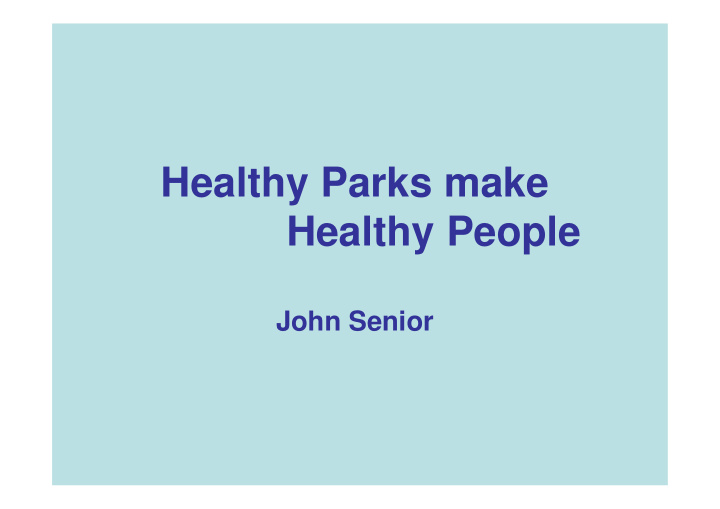



Healthy Parks make Healthy People John Senior
What is meant by Healthy Parks Healthy People? • An approach to park management built on the knowledge that the health and wellbeing of society depends on the health of ecosystems. • Well-managed parks ensure that ecosystems are healthy and resilient. • Healthy parks provide goods and services that support human wellbeing by contributing to economic growth and supporting cohesive, vibrant and healthy societies. • Contact with nature can improve individual physical and mental health and wellbeing.
Why is ‘Healthy Parks Healthy People’ important to us ? � wider view than the conservation/horticultural value � any park has a value to society � visitors may not always understand biodiversity BUT they do like to enjoy the outdoors � why is this so? � biophilia hypothesis > “there is an instinctive bond between human beings and other living systems – the urge to affiliate with other forms of life”
The Societal Context � Living patterns > increasingly urbanised societies � Aging (but active) population � Increasing gap between have’s and have not’s � More educated and articulate community � Increasing multiculturalism = diversity � Changing work patterns → → increased stress → → � Increasing use of technology � Sedentary occupations and discretionary pastimes � High levels of family breakdown � Declining social connectedness � Declining levels of physical activity
Individual Concerns • Work • Career • Study • Family/marriage • Friendships • Safety • Finances • Health • Leisure .…all are interdependent
“Last Child in the Woods - saving our children from nature-deficit disorder” by Richard Louv
What is health? “A state of complete physical, mental, and social wellbeing …….. and not merely the absence of disease or infirmity” World Health Organisation 1946 ‘Wellbeing’ includes: - satisfactory human relationships - meaningful occupation - opportunities for contact with nature, creative expression, and making a positive contribution to human society Furnass 1996
Overweight and Obesity in Australia Adults • 61% of the Australian population are either overweight or obese • 26% of males and 24% of females were classified as obese (Body Mass Index > 30.0 kg/m2) Children and Adolescents • 25% of children aged 5 – 17 years are overweight or obese
Attention Deficit disorder Relationship between ADHD symptoms and playing indoors/the built environment or in greenspace
After a 20-minute walk there is increased brain activity - with the particular type of activity generally being associated with happiness ! ……………….…………… an interesting verification of the synergy between mental and physical health.
Healthy Parks Healthy People - the evolution • Deakin University research • HPHP concept adopted by Parks Victoria • 1 st HPHP International Congress 2010, Melbourne • US National Park Service adopt approach in 2011 as “Healthy Parks Healthy People US” • IUCN recognise and value the inter-dependency and resolve: “to adopt the Healthy Parks Healthy People philosophy and commit to further understanding of, and strengthen the connection between, nature and people” and direct the production of Best Practice Guidelines
How does IUCN work? • IUCN harnesses the individual and collective wisdom of ten thousands experts from a range of disciplines around the world who volunteer their time to assist IUCN with policy and knowledge on conservation matters. • These individuals are formed into 6 Commissions • I am a member of one of these = the World Commission on Protected Areas (WCPA) • WCPA has produced a series of Best Practice Guidelines - 21 to date with a further 12 under development
HPHP Best Practice Guidelines Objective: Healthy Parks Healthy People approach providing health and ecosystem solutions Goal: To establish a global community that values parks for their intrinsic connection between healthy natural environments and healthy communities Project manager: John Senior Priority Actions: • Establish Task Force – 2013 • discussion/input/drafting > 2013-14 • Production - early 2015 • Publication – mid 2015
HPHP Best Practice Guidelines Scope: all parks (urban as well as protected areas) • health & well-being focus • hard copy publication (initial version) • a “LIVING” on-line document • Task Force: • 34 members • international (developed and developing countries) • multicultural & multidisciplinary • progressively comment & review content, input ideas, identify key research, ‘recruit’ case studies
TF membership / case studies 5/1 5/12 10/10 6/2 0/3 1/2 7/3
Healthy Parks, Healthy People Best Practice Guidelines Content: • theory and practice of park management for human benefit • values of parks in different socio-economic, cultural and environmental settings • “Healthy Parks, Healthy People” principles and guidelines • case studies - to illustrate the diverse range of approaches (including YouTube/videos etc) • references
35+ Case Studies Scotland, Finland, Spain, England, Latvia, France, Canada, USA, Argentina, Kenya, Thailand, Cambodia Japan, Vietnam, Australia, NZ + + • green space quantity: stress and wellbeing • benefits of community/agency joint management • ecological restoration to benefit ecosystems, communities and economy • ‘Forest Bathing’ for stress relief • ‘walking to health’; park prescriptions; ‘green gym’ • ‘Dementia adventure’ • elephant therapy project - autism • outdoor activities to aid psycho-social recovery of wild fire affected communities
Parks & Leisure Australia National Position Paper on Parkland: • Govt has responsibility to protect and enhance existing parkland for future generations • parkland should be diverse, convenient and accessible • no net reduction in parkland • additional parkland should be provided in keeping with increasing population density • parkland should be given the status it deserves > sustaining healthy communities http://www.parksleisure.com.au/documents/item/2763
Oscar Wilde memorial, Merrion Square, Dublin
“The Health Benefits of Contact with Nature in a Park Context” 2nd Edition 2008 www.hphpcentral.com/research/healthy-parks-healthy-people “The Value of Parks – Inspire, Refresh, Conserve, Protect, Play” http://www.parksforum.org/cms/pages/The-Value-of-Parks.html “Last Child in the Woods - saving our children from nature-deficit disorder” by Richard Louv Vital Sites – the contribution of protected areas to human health - WWF and Equilibrium - http://www.equilibriumconsultants.com/upload/clientroom/Vital_Sites.pdf John Senior, Project Manager HPHP BP Guidelines jgsenior@bigpond.com
Recommend
More recommend